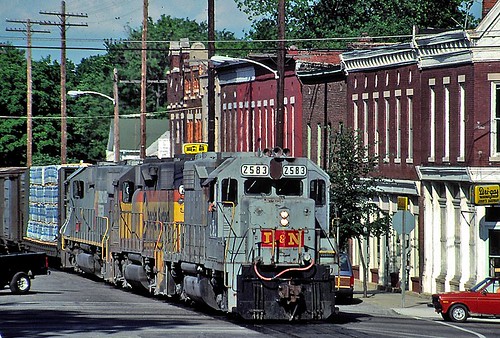Blue Highways: La Grange, Kentucky
Click on Thumbnail for MapUnfolding the Map
On past Louisville, and into the Bluegrass Country. We are following the road that William Least-Heat Moon followed on his trip around the country. Take a look where we are by clicking on the map to the right.
Book Quote
"...and went into Pewee Valley and on to La Grange, where seven daily Louisville and Nashville freight trains ran right down Main Street."
Blue Highways: Part 1, Chapter 5
 Freight train rumbles through downtown La Grange, Kentucky
Freight train rumbles through downtown La Grange, Kentucky
La Grange, Kentucky
I love the picture above that shows the freight train traveling down a main street in La Grange. I was one of those kids that really liked trains. Today, when I see a train, I want to experience it by being close when it roars by.
I grew up with trains. Our property in Northern California is split right down the middle by the California Western Railroad, which runs from Fort Bragg to Willits. It was originally built to accommodate the logging trains that would bring logs to the large mill that was once in our town, and then transport the lumber back to the Northwestern Pacific Railroad in Willits where it would go on to other places. I grew up in the summers watching the freight and passenger trains come through our property. People on the passenger trains took pictures of us as they went by, and sometimes the conductor threw candies and Cracker Jacks to us from the train. The freight train would usually pass by at about 7 pm, usually with two engines, sometimes one, and we'd count the cars all the way to the caboose. At about 3 am, the freight train would come back through, and because our property was a summer property and was only improved by a cabin, we slept outside. I still remember the whine and roar of the engines and the shaft of light from the big main light on the train as it rounded the bend onto our property, and through my sleepy eyes how huge it looked as it towered over me as it went by. The roar of the engines gave way to the clacking of the rail cars going past, and then the red light of the caboose and occasionally, a drunk railroad man in the caboose singing or shouting as it went past - the red light swaying as the train disappeared into the trees - followed moments later by the mournful sound of the train's whistle echoing down the valley in the darkness. Eventually, all would be still again, and I'd drift back off to sleep.
A year ago, I was making weekend drives between Lubbock, Texas and Albuquerque. I taught at Texas Tech during the week, and came back to my wife on weekends. Over half of the trip was along railroad lines. Between Fort Sumner and Clovis, New Mexico was the busiest one, the Burlington Northern Santa Fe, and I was always traveling past huge freight trains coming and going. I always hoped to time one where I could pull off the road at an out of the way crossing, and watch the train come screaming past, but I could never get it quite right. Once, along this stretch of track, I saw what looked like to be a waterfall in the darkness. I can't quite describe it, but it was beautiful. As I came closer, I realized that it was a freight train, and a cascade of sparks was flying out from underneath the length of the train. It was incredible. It didn't dawn on me until later that the train was probably making an emergency stop, and the sparks were because the wheels were locked up on the tracks as the train slowed.
Perhaps if I were a kid growing up in La Grange, I would become used to the trains on the Main Street. I suppose that people living there put up with it. After all, frequent trains will stop traffic, and if you're trying to get anywhere, you probably have to add to your time the possibility that a train will hold you up. William Least-Heat Moon said that up to seven trains a day went through La Grange, but I've read that today, it could be up to sixteen. That might create some delays for the townsfolk. But as a kid growing up, trains were a wonder to me. Big, powerful, and moving places that I could only dream about. I'd hate to lose my continuing wonder of them.
The Louisville and Nashville line that runs through La Grange was one of America's most successful railroads. I first heard of it in a song by Michelle Shocked back in the eighties that spoke of dying coal towns left high and dry when "the L&N don't stop here any more." That struck a chord in me. Though a summer passenger train runs the line through my property in Northern California, the closure of our lumber mill means that no more freight trains come rumbling through at night. To me, it's a loss. I envy La Grange it's freight trains.
If you want to know more about La Grange
Aint no Haint (a blog entry about growing up near La Grange)
City of La Grange Visitor Information
Discover La Grange
Oldham County Historical Society
Wikipedia: La Grange
Wikipedia: Louisville and Nashville Railroad
Youtube: Freight train "street running" down La Grange street
YouTube: Johnny Cash sings The L&N Don't Stop Here Any More
Next up: Shelbyville, Kentucky




 Saturday, June 12, 2010 at 10:19AM
Saturday, June 12, 2010 at 10:19AM